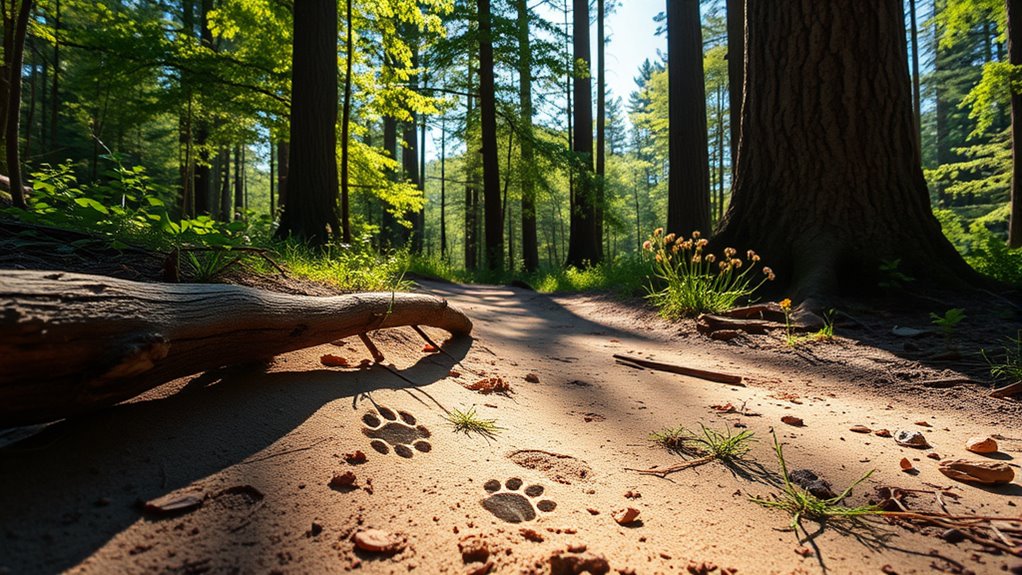When tracking your lost pet, observe natural signs like footprints, disturbed grass, or scratch marks to follow their recent path. Focus on familiar hiding spots such as dense bushes, fallen trees, or elevated areas where they might climb. Use a calm tone and bring familiar scents or toys to attract them. Patience and thoroughness increase your chances. Keep exploring these signs and strategies to find your pet faster; there’s more helpful advice ahead to guide your search.
Key Takeaways
- Observe and follow natural signs like footprints, disturbed grass, and scratch marks to trace your pet’s recent movements.
- Listen carefully for sounds such as barking, meowing, or rustling that indicate your pet’s location.
- Check hiding spots like dense bushes, under decks, and elevated areas where your pet might seek refuge.
- Use familiar scents or items to attract your pet, and call calmly to encourage movement toward you.
- Expand the search perimeter gradually, enlisting neighbors and using social media, while monitoring signs and environmental cues.

Losing a pet can be a stressful experience, but having a clear protocol in place can make the search more effective. When your animal companion goes missing, understanding their animal behavior can give you valuable clues about where they might be. Pets often follow instinctual patterns, like seeking high ground, hiding in quiet spots, or staying close to familiar scents. Recognizing these behaviors helps you plan your search techniques more strategically. For example, if your dog tends to hide under bushes or in secluded corners, you’ll want to focus on areas with dense foliage or structures that provide cover. Similarly, if your cat is known to climb or perch, look for elevated spots like trees, rooftops, or fences. Knowing how your pet naturally behaves can drastically narrow down your search area, saving you time and effort.
Effective search techniques involve more than just calling out their name repeatedly. You should start by thoroughly searching your immediate surroundings, then expand outward systematically. Use a calm, reassuring tone when calling their name, and avoid loud noises that might scare them further away. Bring along familiar items such as their favorite toy, a blanket, or something that smells like home to attract them with familiar scents. When searching, pay close attention to natural signs that might indicate your pet’s presence. Tracks, footprints, or disturbed grass can point you toward their hiding spot or recent activity. If your pet is shy or easily frightened, they might hide under decks, inside sheds, or in dense bushes. Check these areas carefully and quietly. Additionally, training and socialization can influence how pets respond during stressful situations, so understanding your pet’s temperament can be beneficial.
Incorporating your knowledge of animal behavior into your search techniques increases your chances of finding your pet. Be patient, moving slowly and listening for sounds such as scratching, meowing, or barking that can clue you in. Keep in mind that pets often seek out places that feel safe or familiar, so regular spots where they frequent might be their refuge. If you’re not making progress, consider enlisting help from neighbors, posting on social media, or using flyers to expand the search perimeter. Remember, your understanding of their behavior and careful application of search techniques can turn a frantic search into a focused effort, bringing your animal companion back home sooner.
Frequently Asked Questions
How Can I Prevent My Pet From Getting Lost in the First Place?
To prevent your pet from getting lost, you should focus on preventing escapes and creating a secure environment. Never leave doors or gates open, and supervise your pet when outside. Use secure fencing and consider microchipping for added safety. Regularly check that collars and harnesses fit well. These steps help keep your pet safe, reduce the risk of them wandering off, and give you peace of mind knowing they’re protected.
What Should I Do Immediately After My Pet Goes Missing?
When your pet goes missing, act quickly by starting pet tracking efforts immediately. Use natural markers like familiar scents, landmarks, or unique features to help locate your animal. Call neighbors, visit nearby areas, and leave familiar items outside. The faster you respond, the better your chances of finding your pet. Keep calm, stay persistent, and rely on natural signs to guide your search effectively.
Are There Specific Natural Signs That Indicate My Pet’s Recent Presence?
Like a detective in a mystery novel, you can find clues to your pet’s recent presence through scent trails and footprint clues. Fresh smells or disturbed ground often reveal where they’ve been. Look for scuffed grass or disturbed leaves, and follow faint scent trails that lead toward familiar areas. These natural signs can help you retrace their steps and bring your beloved companion home safely.
How Long Should I Wait Before Starting to Search for My Lost Pet?
When your pet goes missing, timing considerations are vital. You should start your search immediately, ideally within the first hour, as animals tend to stay close to their last known location initially. Delaying search initiation can make your pet harder to find. Stay vigilant, check familiar spots, and use natural signs to guide your efforts. Acting quickly increases your chances of a safe and swift reunion.
Can Natural Signs Help Locate a Pet That Has Been Missing for Days?
Did you know that dogs have an extraordinary sense of smell, capable of tracking scents over miles? Natural signs can definitely help locate your pet even days after they go missing. By tracking scents and using natural landmarks, you can follow your pet’s trail, increasing your chances of finding them. Stay patient and attentive to subtle clues, as their scent can linger and guide you back to them.
Conclusion
Now that you know how to track your pet using natural signs, your next step could be the most critical yet. Will the clues lead you to your furry friend before it’s too late? Keep your eyes sharp and stay alert—sometimes, the smallest sign reveals the biggest story. Remember, every moment counts. Stay hopeful, trust your instincts, and don’t give up. Your animal companion might be closer than you think, just waiting for you to find them.










